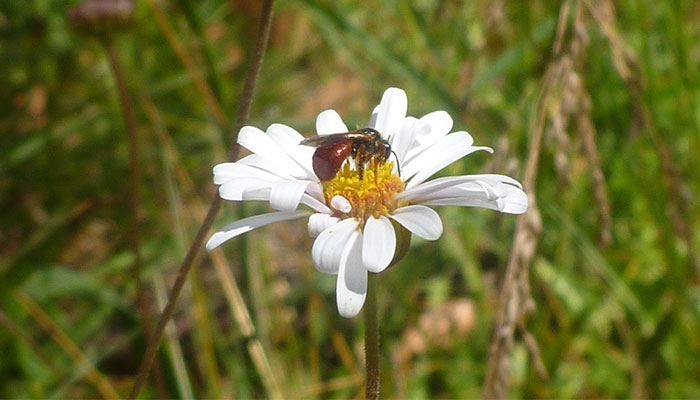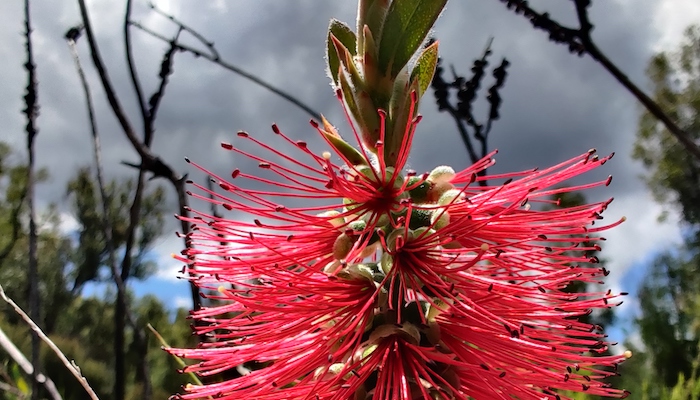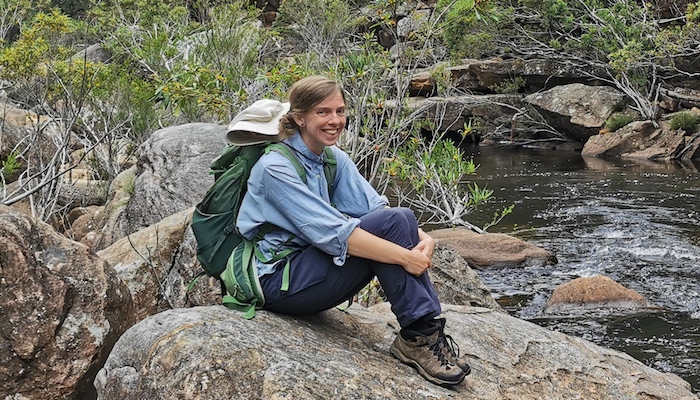The earliest flowers on Earth, emerging over 140 million years ago, were likely pollinated by insects, new research has found.

Bee pollination: This pictured Australian reed bee (Exoneura sp.) is shown pollinating a native daisy flower (Asteraceae) in the NSW Snowy Mountains. Image credit Ruby Stephens
Ruby Stephens, a PhD candidate in botanical science at Macquarie University, worked with a team of Australian scientists to develop an evolutionary tree tracking the pollination of more than a thousand species of flowering plants across all of the Earth’s 434 flowering plant families.
“Mapping backwards from today’s species, tracking plants from what pollinates them today, we can work out how their ancestors were likely to have been pollinated,” Ms Stephens says.
Ninety percent of the plants alive today are flowering plants (angiosperms); and most of these are insect-pollinated, says Ms Stephens, with the rest pollinated by wind, vertebrates like birds and bats, and a few by water.
She says most of the attributes of animal-pollinated flowers – their scent, colours and shapes – have evolved to maximise the plants’ attractiveness to insects and other animals.
“At least 90 per cent of the flowering plants in my research, were animal pollinated,” says Stephens.
Mapping the data
The research involved a huge taxonomic exercise, comparing key features across around 1200 different species of flowering plants from around the world, Stephens says.

Dual pollination: Some flowers like this Crimson Bottlebrush (Callistemon citrinus, Myrtaceae) are pollinated by a mix of insects and vertebrates like birds. Image credit: Ruby Stephens
“Using pollination studies and botanical descriptions, I worked out how each flower was pollinated: was it wind or water, was it insects, or was it bigger animals like birds or bats?”
She then combined this detailed pollination data with an evolutionary tree of flowering plants based on both fossil records and plant DNA records to time-calibrate their findings, and identify when each plant evolved from the other members of their family.
“After running a lot of models to map backwards from the pollinator of each species in the present, to the likely pollinator of the ancestors of that species in the past, I found that the ancestor of all flowering plants was very likely insect pollinated,” she says.
Place plays a part
Head of Plant Discovery and Evolution Research at Botanic Gardens of Sydney and senior author of the study, Dr Hervé Sauquet, says their research uncovered insights into the evolution of other forms of pollination.
“Pollination from vertebrate animals like birds, bats, small mammals, even lizards, has evolved and reverted numerous times throughout history,” says Dr Sauquet.
“Wind pollination has also evolved many times, but it is harder to reverse – once plants go pollination by wind, they rarely go back.”
The research also shows that geographic distribution of plants can play an important role in how they are pollinated.
“Wind pollination is more likely to evolve in open habitats towards the poles, while animal pollination is more likely to occur in closed rainforests near the equator,” says study co-author Rachael Gallagher, who is an Honorary Associate Professor from Macquarie University.
“Differential humidity may explain part of this, Stephens says. “Humidity is quite bad for pollen, so cold and dry climates are better suited to wind pollination.”

The critical role of insects
Ms Stephens says that flowering plants invest significant energy in pollination, whether by wind or animal.
“Producing nectar to be consumed by butterflies and bees is quite energy-intensive, but the benefit is targeted pollination, so plants can be sure that their pollen reaches the same species,” she says.
“Wind-pollinated plants, conversely, must produce vast quantities of pollen and rely on chance.”
“Some 90 per cent of the estimated 330,000 species of angiosperm today depend on animals for pollination,” says Professor Susanne Renner, an Honorary Professor of Biology at Washington University who reviewed the study published today in New Phytologist.
“Stephens and her team’s new findings confirm that insects have pollinated angiosperms for the majority of this plant lineage’s history,” she says.
“This underscores the need for the conservation of insects – their role as pollinators is essential for the continued existence of plants,” Professor Renner concludes.








